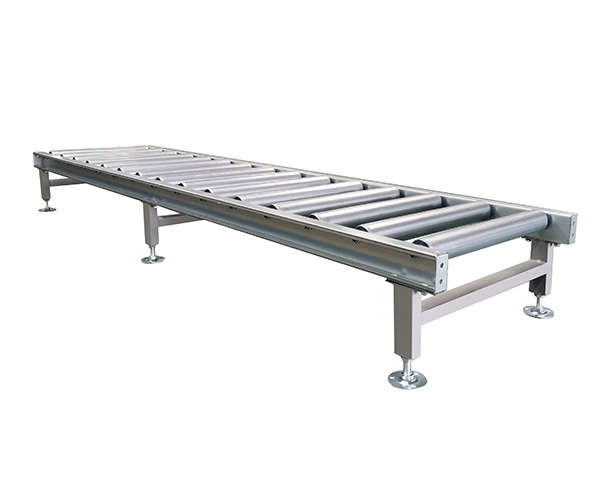Exploring Unpowered Roller Conveyor Lines: A Simple Yet Efficient Solution for Material Handling
2025-03-26
In the world of material handling, conveyor systems are essential for efficiently moving goods from one point to another within a facility. Among the various types of conveyor systems available, the unpowered roller conveyor line stands out due to its simplicity, cost-effectiveness, and versatility. Whether you are transporting heavy-duty items in a warehouse or handling smaller packages in a manufacturing environment, an unpowered roller conveyor line can be the ideal solution. In this blog, we’ll take a closer look at what unpowered roller conveyor lines are, their benefits, and how they are used in various industries.
What is an Unpowered Roller Conveyor Line?
An unpowered roller conveyor line, also known as a gravity roller conveyor, is a type of conveyor system that moves materials using the force of gravity rather than a motor or other power source. It consists of a series of rollers mounted on a frame, allowing products to roll from one location to another with minimal effort. These rollers are often spaced apart and aligned on a sloped track, ensuring that the material moves smoothly along the conveyor line due to the incline.
Unlike powered conveyors, which use motors and drives to move materials, unpowered roller conveyors rely on the physical force applied to the products being transported. This force can come from the manual effort of workers, gravity, or a slight push to move the items down the line.
Key Features of Unpowered Roller Conveyors
1. Simplicity: Unpowered roller conveyors have a simple design with fewer components compared to powered conveyors. This makes them easy to install and maintain. The lack of motors, electrical systems, and complex controls reduces both the initial cost and ongoing maintenance costs.
2. Low Energy Consumption: Since unpowered roller conveyors don’t require electricity or motors to function, they have a very low energy consumption, making them an environmentally friendly and cost-effective option for moving goods.
3. Versatility: These conveyors can handle a wide range of products, from small boxes and packages to larger, heavier items. The rollers can be adjusted or customized to suit different types of materials and load capacities, making them highly versatile.
4. Durability: The robust and simple design of unpowered roller conveyors ensures they have a long lifespan, even under heavy use. The materials used for the rollers, such as steel or plastic, are chosen for their durability and resistance to wear and tear.
How Unpowered Roller Conveyors Work
The working principle of an unpowered roller conveyor is straightforward. Items placed on the conveyor are moved by the force of gravity. This is typically achieved by positioning the conveyor line on a slight incline, which allows the products to move without the need for external power sources. Workers or other material handling systems may give the items an initial push, allowing them to travel smoothly along the rollers.
The rollers are usually mounted in a frame and are spaced out to allow the goods to pass over them easily. The spacing between the rollers and the overall incline of the conveyor line can be adjusted based on the type of material being transported. This design ensures a smooth and controlled flow of goods, whether they are light or heavy.
Unpowered roller conveyors can also be used in combination with other systems, such as powered conveyors or manual handling equipment. For example, workers may use a combination of powered conveyors to bring materials to an unpowered roller conveyor line, where the goods can then be transferred by gravity to the next stage in the production or distribution process.
Applications of Unpowered Roller Conveyor Lines
Unpowered roller conveyors are used in a wide range of industries and applications. Their simple yet effective design makes them a go-to solution for businesses looking to streamline their material handling processes. Here are some common applications:
1. Warehouse and Distribution Centers: In warehouses, unpowered roller conveyors are often used to move products from one section to another. Whether it’s sorting packages, organizing inventory, or preparing orders for shipment, unpowered roller conveyors are an efficient and affordable solution for optimizing material movement.
2. Manufacturing: In manufacturing plants, unpowered roller conveyors are often employed to transport components or finished products along production lines. Their simplicity and ability to handle heavy items make them ideal for moving raw materials or semi-finished goods between workstations.
3. Packaging Lines: Unpowered roller conveyors are commonly used in packaging applications to transport boxes, bottles, or cans down the line. They ensure a steady flow of products while minimizing the need for manual labor. The use of gravity means less effort is required for the movement of goods.
4. Assembly Lines: On assembly lines, unpowered roller conveyors are used to move parts between different stages of assembly. The simplicity of these conveyors allows workers to focus on assembling products rather than managing complicated transportation systems.
5. Retail: Unpowered roller conveyors are sometimes used in retail environments, particularly in areas like checkout lines or stockroom organization. They help move products along the line with minimal effort, improving efficiency in the retail process.
Benefits of Unpowered Roller Conveyors
1. Cost-Effective: Unpowered roller conveyors are significantly cheaper than powered conveyor systems. There are no motors or complex controls to install or maintain, reducing both upfront costs and long-term maintenance expenses.
2. Low Maintenance: With fewer moving parts and no electrical components, unpowered roller conveyors require less maintenance than powered systems. The rollers may need occasional lubrication, but other than that, these conveyors are simple to maintain, leading to fewer interruptions in operations.
3. Flexible Layouts: The modular nature of unpowered roller conveyors allows for flexible system layouts. They can be easily extended, shortened, or reconfigured to suit changing needs. This makes them ideal for businesses that require adaptability in their material handling systems.
4. Energy Efficiency: Since these conveyors don’t require electricity or motors to move materials, they are highly energy-efficient. This not only saves energy costs but also reduces the overall environmental impact of a business’s operations.
5. Reduced Labor Costs: While unpowered roller conveyors require manual intervention to move items, they still reduce the need for labor compared to traditional methods like hand-picking or forklifts. This leads to greater operational efficiency and reduced labor costs in the long run.
Conclusion
Unpowered roller conveyor lines offer a simple, cost-effective, and energy-efficient solution for transporting materials in various industries. Whether in a warehouse, manufacturing plant, or packaging line, these conveyors provide reliable material handling without the need for complex electrical systems. Their durability, ease of use, and versatility make them an excellent choice for businesses looking to streamline their operations and reduce costs.
If you're considering implementing a conveyor system in your facility, an unpowered roller conveyor line is an option worth exploring. By utilizing gravity and minimal manual intervention, these systems provide a reliable, long-lasting solution for moving goods efficiently from one location to another.



